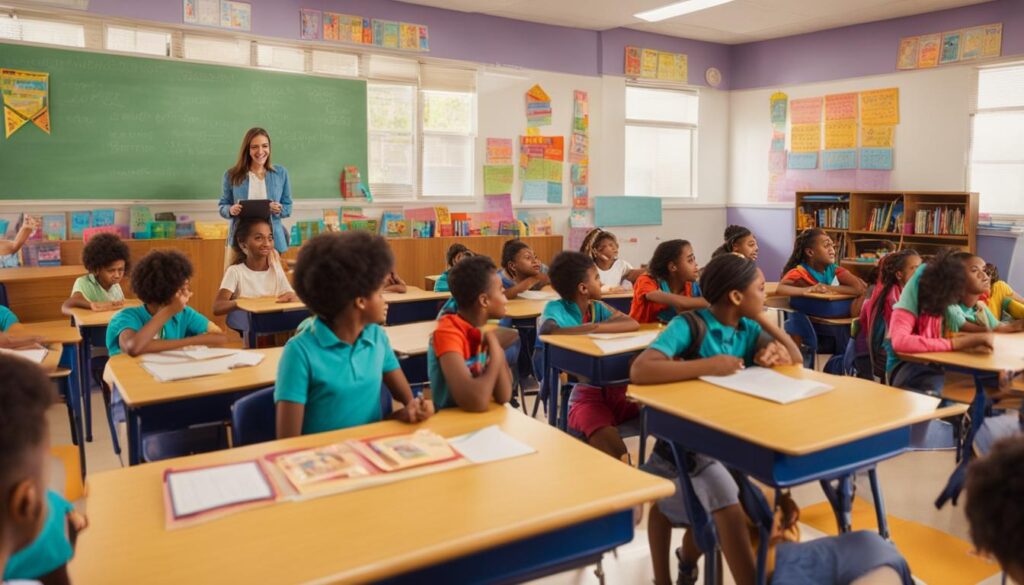We may earn money or products from the companies mentioned in this post.
Gratitude is a powerful emotion that can bring positivity and happiness to individuals. However, its benefits go beyond personal well-being, and it can have a significant impact on education as well. Implementing gratitude practices in schools can lead to better academic outcomes and improve student well-being.
Gratitude in education is about fostering a mindset of appreciation and recognizing the good things in our lives. When students learn to cultivate gratitude, they can develop a more positive outlook on life, increased resilience, and better social skills.
By incorporating gratitude practices into their teaching approach, educators can create a positive and supportive learning environment that enhances student engagement and motivation. Integrating gratitude into education can have a transformative effect and provide students with the tools they need to face the challenges of the world.
Key Takeaways:
- Gratitude can contribute to better academic outcomes and improved student well-being in schools.
- Teaching gratitude to students can help develop a positive outlook on life, increased resilience, and better social skills.
- By integrating gratitude practices into their teaching approach, educators can create a positive and supportive learning environment.
- Gratitude in education can have a transformative effect and provide students with tools they need to face challenges.
- Implementing gratitude practices in schools can lead to better academic outcomes and improve student well-being.
Understanding the Role of Gratitude in Student Development
Gratitude is an essential ingredient in fostering a positive learning environment in the classroom. Teachers play a crucial role in promoting gratitude among students by teaching them to appreciate and express thankfulness for the things they have.
The Importance of Promoting Gratitude in the Classroom
The classroom is an ideal place to cultivate gratitude. By promoting gratitude in the classroom, teachers can provide a safe and supportive learning environment that enhances students’ well-being and personal growth. Students who practice gratitude have been shown to experience higher levels of happiness, optimism, and social support, which can lead to long-term improvements in well-being and academic success.
Teaching Gratitude to Students
One effective way to teach gratitude to students is to encourage them to keep a gratitude journal. This can be a simple notebook or an online journal, where students can write down things they are grateful for each day. By reflecting on their blessings, students can become more aware of the positive things in their lives and develop a deeper appreciation for the people and things around them.
Teachers can also incorporate gratitude into their lesson plans by encouraging students to express appreciation for other students, teachers, or community members. This can be done through activities such as writing thank-you letters, creating gratitude collages, or simply sharing positive thoughts and feelings with one another.
The Role of Gratitude in Student Well-Being
Research has shown that practicing gratitude can have significant benefits for student well-being. Students who practice gratitude have been shown to experience lower levels of stress, anxiety, and depression, which can lead to improved mental health and greater resilience in the face of challenges.
Gratitude also has a positive impact on relationships. When students practice gratitude, they are more likely to display prosocial behaviors such as kindness, empathy, and cooperation, which can lead to stronger relationships with peers, teachers, and family members.
Overall, promoting gratitude in the classroom can help students develop a positive mindset that can lead to greater academic success and personal fulfillment.
Gratitude Practices for Educators
As educators, we have a significant impact on the lives of our students. By fostering a culture of gratitude in schools, we can contribute to their overall well-being and academic success. Here are some gratitude practices that educators can incorporate into their teaching approach:
Express Gratitude
Take the time to express gratitude towards your students. Whether it is a simple “thank you” for their hard work or a note of appreciation, acknowledging their efforts can go a long way in building a positive classroom environment.
Lead by Example
Model gratitude for your students. Share moments of gratitude in your own life and demonstrate the importance of expressing appreciation towards others. This can inspire your students to practice gratitude in their own lives.
Gratitude Journal
Encourage your students to keep a gratitude journal. This can be a great way for them to reflect on what they are thankful for and develop a deeper appreciation for the positive aspects of their lives. Consider allocating a few minutes each day for students to share their reflections with the class.
Gratitude Activities
Engage your students in gratitude activities. This can include writing thank-you letters to people who have made a difference in their lives, creating gratitude collages, or participating in acts of kindness towards others. These activities can help students develop a sense of empathy and appreciation for the people and things around them.
Foster a Culture of Gratitude
Make gratitude a part of your school’s culture. Encourage other teachers and staff members to incorporate gratitude practices into their teaching approach. Display messages or quotes about gratitude around the school and recognize students who demonstrate gratitude towards others.
By incorporating these gratitude practices into your teaching approach, you can foster a culture of gratitude in your school. This can contribute to the overall well-being and success of your students, creating a positive and supportive learning environment.
The Academic Benefits of Gratitude
Gratitude in education has been found to have a significant positive impact on academic success. Research has shown that grateful students are more motivated, engaged, and perform better academically compared to their less grateful peers.
In a study conducted by Froh and colleagues (2011), middle-school students who practiced gratitude for two weeks showed an increase in their satisfaction with school and positive attitudes towards learning. Another study by Bono et al. (2013) found that high school students who practiced gratitude had better grades and a higher sense of social integration. In addition, a study by Ioussoufova and colleagues (2011) found that teaching gratitude to college students led to an increase in their GPA.
Moreover, gratitude has been found to lead to better mental health, which in turn can positively impact academic success. A study by Park et al. (2004) found that grateful individuals have higher levels of well-being and lower levels of depression, anxiety, and stress. This suggests that promoting gratitude in schools can have a far-reaching impact beyond just academics.
The Role of Teachers
Educators play a crucial role in fostering gratitude in students and promoting its academic benefits. By modeling and encouraging gratitude in the classroom, teachers can create a positive and supportive environment that encourages students to develop a sense of gratitude.
Teachers can also implement gratitude activities and exercises into their teaching approach. For instance, having students write about things they are thankful for or expressing gratitude towards their classmates can promote a culture of gratitude and lead to greater academic success.
| Gratitude Activity | Description |
|---|---|
| Gratitude Journal | Have students keep a journal where they write about something they are grateful for each day. This can help them develop a habit of gratitude and reflect on their blessings. |
| Thank You Notes | Encourage students to write thank you notes to teachers, classmates, or family members to express their gratitude. This can help students appreciate the positive impact others have on their lives. |
| Gratitude Walk | Take students on a gratitude walk where they identify things in nature they are thankful for, such as the sunlight or the sound of birds chirping. This can help students develop a sense of awe and appreciation for the world around them. |
In Conclusion
Gratitude in education is not just a nice-to-have; it has real and significant benefits for student well-being and academic success. Teachers have an important role to play in promoting gratitude in the classroom, through modeling and incorporating gratitude practices into their teaching approach. By doing so, educators can help create a positive and supportive learning environment that sets students up for success.
The Intersection of Mindfulness and Gratitude in Education
Mindfulness practices are becoming increasingly popular in education, and for good reason. The benefits of mindfulness, such as improved focus, reduced stress, and increased self-awareness, can have a positive impact on student learning and well-being. When combined with gratitude practices, mindfulness can further enhance the learning experience by helping students appreciate the present moment and cultivate positive feelings towards themselves and others.
One way to integrate mindfulness and gratitude is through mindful gratitude exercises. These exercises involve intentionally focusing on what one is thankful for and allowing oneself to feel the positive emotions associated with gratitude. For example, a teacher could lead students in a mindfulness exercise where they focus on their breath and then ask them to bring to mind something they are grateful for, encouraging them to savor the positive feelings associated with that experience.
Another way to incorporate mindfulness and gratitude in education is through gratitude journaling. Students can be encouraged to keep a gratitude journal where they write down things they are grateful for on a daily or weekly basis. By taking the time to reflect on what they appreciate in their lives, students can develop a more positive outlook and a greater sense of well-being.
Mindfulness and Gratitude in Action
| Class Activity | Description |
|---|---|
| Gratitude Scavenger Hunt |
In this activity, students are given a list of items to find that they should be grateful for. For example, a student might be asked to find something that makes them feel happy or something that they appreciate in nature. This activity promotes mindfulness and gratitude by encouraging students to focus on the positive aspects of their lives. |
| Mindful Eating |
In this activity, students are encouraged to practice mindful eating by taking the time to appreciate their food and the experience of eating. A teacher might ask students to close their eyes and focus on the taste, texture, and smell of their food, helping them cultivate a greater appreciation for the nourishment they receive.
|
| Gratitude Circle |
In this activity, students sit in a circle and take turns expressing something they are grateful for. This activity promotes mindfulness and gratitude by allowing each student to focus on the positive aspects of their lives and feel the positive emotions associated with gratitude. |
By incorporating mindfulness and gratitude practices into the classroom, teachers can help students develop a greater sense of well-being and appreciation for themselves and others. These practices can also help students become more engaged learners, as they develop the ability to focus on the present moment and remain more attentive to the learning experience.
Engaging Students with Gratitude Activities
Cultivating gratitude in the classroom can have a profoundly positive impact on students’ well-being and academic performance. To help foster a culture of gratitude, here are some practical gratitude activities for students:
- Gratitude journals: Encourage students to keep a gratitude journal where they can write down things they are grateful for each day. This exercise promotes mindfulness and helps students focus on the positive aspects of their lives.
- Gratitude letters: Have students write gratitude letters to someone who has made a positive impact on their lives. This activity helps students express their gratitude and develop stronger connections with others.
- Gratitude collages: Provide students with magazines, scissors, and glue, and ask them to create a collage of things they are grateful for. This art activity encourages creativity and reinforces the idea of gratitude as a visual concept.
- Gratitude discussions: Engage students in gratitude discussions during class time. Encourage them to share things they are grateful for and ask them to reflect on how gratitude makes them feel.
These gratitude activities for students can enhance their emotional intelligence and promote positive relationships. They can also help students develop the habit of expressing gratitude regularly, leading to improved mental and emotional well-being.
Conclusion
Incorporating gratitude practices into education has numerous benefits for students, educators, and the overall learning environment. By promoting gratitude in education, students can experience better well-being and academic success. Fostering a culture of gratitude in schools can create positive classroom atmospheres, which lead to engaged and motivated learners.
Integrating gratitude into education is not difficult. Teachers can actively promote gratitude through simple practices like gratitude journaling, gratitude circles, and appreciation exercises. By teaching gratitude, educators can nurture a growth mindset and encourage students to see challenges as opportunities for growth.
It is evident that gratitude in education is beneficial and can have a long-lasting positive impact on students. As such, we encourage schools and educators to embrace gratitude practices and incorporate them into their teaching approach. Doing so will help cultivate a more positive and appreciative learning community, where students can thrive both academically and personally.
SEO Keywords: gratitude in education, benefits of gratitude in schools
FAQ
What is gratitude in education?
Gratitude in education refers to the intentional cultivation and expression of gratitude within the educational setting. It involves recognizing and appreciating the contributions of others, fostering a positive learning environment, and promoting overall well-being among students and educators.
What are the benefits of gratitude in schools?
The benefits of gratitude in schools are numerous. It has been found to enhance student well-being, improve academic performance, foster positive relationships, reduce stress and anxiety, and promote a sense of belonging and empathy within the school community.
How can teachers promote gratitude among students?
Teachers can promote gratitude among students by incorporating gratitude practices into their daily routines and classroom activities. This can include gratitude journaling, gratitude circles or discussions, expressing appreciation for one another, or even incorporating gratitude into lesson plans and assignments.
What are some gratitude practices for educators?
Educators can practice gratitude by expressing appreciation for their students, colleagues, and the overall learning environment. They can also engage in personal gratitude practices, such as keeping a gratitude journal, practicing mindfulness, or engaging in acts of kindness. Creating a positive and grateful atmosphere in the classroom is also important.
How does gratitude impact academic success?
Gratitude has been shown to improve students’ motivation, engagement, and overall academic performance. When students feel appreciated and valued, they are more likely to be motivated to learn, participate actively in class, and seek academic success.
How does mindfulness relate to gratitude in education?
Mindfulness practices can complement gratitude in education by enhancing students’ ability to be present, cultivate awareness, and appreciate the present moment. Mindfulness can help students develop a deeper sense of gratitude and a more positive outlook, leading to improved well-being and learning experiences.
What are some gratitude activities for students?
There are various gratitude activities that teachers can use to engage students. These can include gratitude jars or boards, gratitude letters or cards, gratitude scavenger hunts, or even community service projects where students express gratitude through acts of kindness. The goal is to foster a spirit of gratitude and appreciation within the classroom.
Affiliate Disclosure: This post may contain affiliate links. If you purchase through our link, we may receive a small commission, but at no additional cost to you. For more information, please see our Disclosure statement.



